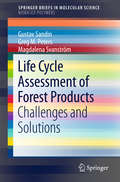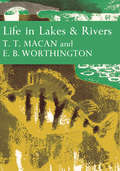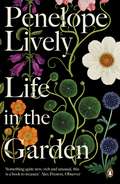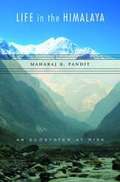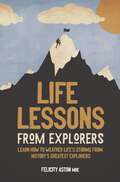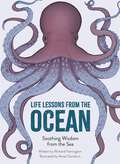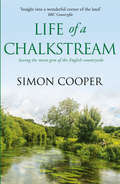- Table View
- List View
Life Cycle Assessment: Future Challenges
by Surjya Narayana PatiThis book offers an itemized analysis of Life Cycle Assessment (LCA), for use in any processes, products, services, industries, organizations and so forth. Various challenges faced during applications of LCA, and its extension are discussed including their benefits. Further, the book provides practical examples of LCA in different core sectors, such as cement and construction. Each chapter functions as a stand-alone unit within the book and defines its individual role within the overall concept of LCA. Features: Covers Life Cycle Assessment (LCA) and future challenges including its practical applications as climate change tool. Connects life cycle management and LCA/environmental management. Explains benefits of LCA studies for both internal and external purpose in terms of various impact parameters. Identifies different raw materials or alternate energy mediums for changing inputs to reduce environmental impacts. Discusses extension of LCA concept like LCC, LCSA, SCLA, and OLCA. This book is aimed at professionals in all engineering areas and environmental studies.
Life Cycle Assessment: Future Challenges
by Surjya Narayana PatiThis book offers an itemized analysis of Life Cycle Assessment (LCA), for use in any processes, products, services, industries, organizations and so forth. Various challenges faced during applications of LCA, and its extension are discussed including their benefits. Further, the book provides practical examples of LCA in different core sectors, such as cement and construction. Each chapter functions as a stand-alone unit within the book and defines its individual role within the overall concept of LCA. Features: Covers Life Cycle Assessment (LCA) and future challenges including its practical applications as climate change tool. Connects life cycle management and LCA/environmental management. Explains benefits of LCA studies for both internal and external purpose in terms of various impact parameters. Identifies different raw materials or alternate energy mediums for changing inputs to reduce environmental impacts. Discusses extension of LCA concept like LCC, LCSA, SCLA, and OLCA. This book is aimed at professionals in all engineering areas and environmental studies.
Life Cycle Assessment of Forest Products: Challenges and Solutions (SpringerBriefs in Molecular Science)
by Gustav Sandin Greg M. Peters Magdalena SvanströmThis brief contains information on the reduction of environmental impact and explains how it is a key driver for the R&D of new forest products. The authors, experts in the field, describe how Life Cycle Assessment (LCA) is used to assess the environmental impact of such products, e.g. in order to guide R&D or attract investments. The authors describe the main challenges of carrying out LCAs on forest products, make recommendations for managing these challenges, and discuss future research needs. LCA case studies are used to illustrate the challenges, covering a variety of forest products: building components, biofuels, industrial chemicals, textile fibres and clothing. Described challenges include the planning of LCA studies (e.g.how can one use LCA in R&D?), the modelling of product systems (how can one handle multi-functionality and uncertainties related to waste handling and geographical location of future production?) and environmental impact (how can one assess water and land use impact, and the climate impact of biomass?).
The Life Cycles of Butterflies: From Egg to Maturity, a Visual Guide to 23 Common Garden Butterflies
by Judy Burris Wayne RichardsThis stunning photographic guide will have butterfly enthusiasts of all ages aflutter. Judy Burris and Wayne Richards include more than 400 full-color, up-close images that present the life cycles of 23 common North American butterflies in amazing detail. Watch caterpillars hatch from eggs, eat and grow, form into chrysalides, emerge as colorful butterflies, and fly through the air. You&’ll also learn which plants butterflies avoid and which native species they&’re attracted to, so you can create your own backyard butterfly haven.
Life in Europe Under Climate Change
by Joseph Alcamo Jorgen E. OlesenLife in Europe will indeed go on as the climate changes, but not in the same way as before. The air will be warmer, winds will change, patterns of rainfall and snowfall will alter, and sea level is likely to rise. These phenomena are already being seen. Europe will in the future experience marked changes in vegetation cover, increased floods along rivers and coastlines as well as more frequent droughts and forest fires, often leading to large societal costs. The changes will be minor in some cases, profound in others, but in any case, pervasive. This book uses the most up to date information issued by the IPCC (Intergovernmental Panel on Climate Change), and informs readers about these effects, as well as showing how Europe is contributing to attempts to slow the tempo of global climate change, and how it can adapt to the climate change that seems unavoidable. Life in Europe under Climate Change makes essential information on climate impacts in Europe accessible to a broad audience, including students, politicians, planners and members of non-governmental organizations.
Life in Europe Under Climate Change
by Joseph Alcamo Jorgen E. OlesenLife in Europe will indeed go on as the climate changes, but not in the same way as before. The air will be warmer, winds will change, patterns of rainfall and snowfall will alter, and sea level is likely to rise. These phenomena are already being seen. Europe will in the future experience marked changes in vegetation cover, increased floods along rivers and coastlines as well as more frequent droughts and forest fires, often leading to large societal costs. The changes will be minor in some cases, profound in others, but in any case, pervasive. This book uses the most up to date information issued by the IPCC (Intergovernmental Panel on Climate Change), and informs readers about these effects, as well as showing how Europe is contributing to attempts to slow the tempo of global climate change, and how it can adapt to the climate change that seems unavoidable. Life in Europe under Climate Change makes essential information on climate impacts in Europe accessible to a broad audience, including students, politicians, planners and members of non-governmental organizations.
Life in Extreme Environments
by Ricardo Amils Pibernat Cynan Ellis-Evans Helmut G. Hinghofer-SzalkayThis book provides an intriguing look at how life can adapt to many different extreme environments. It addresses the limits for life development and examines different strategies used by organisms to adapt to different extreme environments.
Life in Lakes and Rivers (Collins New Naturalist Library #15)
by T. T. Macan E. B. WorthingtonLife in Lakes and Rivers reveals to us not only the fascination of the world of fresh waters, but the excitement and delight of finding out more about it. This edition is exclusive to newnaturalists.com
A Life In Nature
by Sir Peter Scott'The Patron Saint of Conservation' Sir David Attenborough'Peter Scott was a huge influence on my childhood...Later on in life I had the good fortune both to meet and to interview him, and he remains, for me, a hero. His knowledge, his kindness to me and his generosity of spirit have remained an influence in my own sphere of natural history....To meet one's heroes can sometimes be a let-down. That was most certainly not the case with Peter Scott.' Alan TitchmarshA Life In Nature is a portrait of Peter Scott collected from his own conversations, articles and broadcasts including thoughts on expeditions to Lapland, Conservation and Africa, his travels in Europe and much more. Illustrated by Peter's own beautiful illustrations. Sir Peter Scott had a truly incredible life. He was the only son of legendary explorer Captain Scott. His godfather was JM Barrie and he was married to Elizabeth Jane Howard. He also represented Great Britain and Northern Ireland at sailing in the 1936 Berlin Olympic Games, winning a bronze medal. He founded the Wildfowl and Wetlands Trust and also helped to found the Worldwide Fund for Nature.This is a beautiful and timely re-discovered book, perfect for those who are interested in preserving our planet.
Life in the Chesapeake Bay
by Alice Jane Lippson Robert L. LippsonLife in the Chesapeake Bay is the most important book ever published on America's largest estuary. Since publication of the first edition in 1984, tens of thousands of naturalists, boaters, fishermen, and conservationists have relied on the book's descriptions of the Bay's plants, animals, and diverse habitats. Superbly illustrated and clearly written, this acclaimed guide describes hundreds of plants and animals and their habitats, from diamondback terrapins to blue crabs to hornshell snails.Now in its third edition, the book has been updated with a new gallery of thirty-nine color photographs and dozens of new species descriptions and illustrations. The new edition retains the charm of an engaging classic while adding a decade of new research.This classic guide to the plants and animals of the Chesapeake Bay will appeal to a variety of readers—year-round residents and summer vacationers, professional biologists and amateur scientists, conservationists and sportsmen.
Life in the Dark: Illuminating Biodiversity in the Shadowy Haunts of Planet Earth
by Dant © FenolioDeep inside caves, at the bottoms of oceans and lakes, beneath the ground: these concealed habitats are absent of sunlight. This strange and fascinating world of complete darkness is not a solitary place;¢;‚¬;€?it is inhabited by millions of life forms. Yet most humans;¢;‚¬;€?creatures of daylight;¢;‚¬;€?have never seen any of them. Until now. In this fascinating;¢;‚¬;€?sometimes eerie;¢;‚¬;€?book, extreme wildlife photographer and scientist Dant;© Fenolio brings the denizens of these shadowy haunts into focus. Life in the Dark shows us the many ways in which life forms have adapted to lightless environments, including refinements of senses, evolution of unique body parts, and illumination using "biological flashlights." With more than 200 mesmerizing color photographs, Life in the Dark unveils bizarre creatures like the firefly squid, the giant Amazonian catfish, the Chinese cavefish, and even the human bot fly, which lives in the darkness beneath its host;€™s skin. Fenolio;€™s rich and vibrant images shed new light on the world;€™s fascinating creatures of darkness.
Life in the Dark: Illuminating Biodiversity in the Shadowy Haunts of Planet Earth
by Dant © FenolioDeep inside caves, at the bottoms of oceans and lakes, beneath the ground: these concealed habitats are absent of sunlight. This strange and fascinating world of complete darkness is not a solitary place;¢;‚¬;€?it is inhabited by millions of life forms. Yet most humans;¢;‚¬;€?creatures of daylight;¢;‚¬;€?have never seen any of them. Until now. In this fascinating;¢;‚¬;€?sometimes eerie;¢;‚¬;€?book, extreme wildlife photographer and scientist Dant;© Fenolio brings the denizens of these shadowy haunts into focus. Life in the Dark shows us the many ways in which life forms have adapted to lightless environments, including refinements of senses, evolution of unique body parts, and illumination using "biological flashlights." With more than 200 mesmerizing color photographs, Life in the Dark unveils bizarre creatures like the firefly squid, the giant Amazonian catfish, the Chinese cavefish, and even the human bot fly, which lives in the darkness beneath its host;€™s skin. Fenolio;€™s rich and vibrant images shed new light on the world;€™s fascinating creatures of darkness.
A Life in the Garden: Tales and Tips for Growing Food in Every Season
by Barbara DamroschOne of America's most well-known and bestselling gardening writers shares her reflections and advice on finding joy in the garden In A Life in the Garden, horticultural icon Barbara Damrosch imparts a lifetime of wisdom on growing food for herself and her family. In writing that's accessible, engaging, and elegant, she welcomes us to garden alongside her. Personal, thoughtful, and often humorous, this book offers practical DIY insights that will delight gardeners, cooks, and small-scale farmers. With a personal and sometimes irreverent tone, Barbara expresses the pleasure she takes in gardening, the sense of empowerment she finds in it, and the importance of a partnership with the real expert: nature.
Life in the Garden
by Penelope Lively'Rich and unusual, a book to treasure. Few recent gardening books come anywhere close to its style, intelligence and depth. Moves between Lively's own horticultural life and a broad history of gardening' Observer'Wonderful. A manifesto of horticultural delight' Literary Review'Beautiful. Perfect for literary garden lovers' Good Housekeeping'Exquisite and original' Daily Telegraph 'Enchanting. Reading this book is like walking with a wise, humorous guide through a series of garden rooms . . . and finding that vistas suddenly open out, on to history, fashion, politics, reflections on time and the taming of nature' Tablet'A perfect bedside book. In part it's a memoir of the gardens in Lively's life, starting with the exotic Egyptian garden of her childhood and continuing up to her small present-day garden in a north London square' Sunday Express'A gentle survey of the garden's place in Western culture, which morphs into a personal meditation on time, memory and a life well lived' i'Scholarly bedtime reading' The Times, Books of the Year
Life in the Himalaya: An Ecosystem at Risk
by Maharaj K. PanditThe collision of the Indian and Eurasian plates 50 million years ago created the Himalaya, along with massive glaciers, intensified monsoon, turbulent rivers, and an efflorescence of ecosystems. Today, the Himalaya is at risk of catastrophic loss of life. Maharaj Pandit outlines the mountain’s past in order to map a way toward a sustainable future.
Life in the Himalaya: An Ecosystem at Risk
by Maharaj K. PanditThe collision of the Indian and Eurasian plates 50 million years ago created the Himalaya, along with massive glaciers, intensified monsoon, turbulent rivers, and an efflorescence of ecosystems. Today, the Himalaya is at risk of catastrophic loss of life. Maharaj Pandit outlines the mountain’s past in order to map a way toward a sustainable future.
Life Lessons from Explorers: Learn how to weather life's storms from history's greatest explorers
by Felicity AstonGreat explorers are known for their hard-earned skills and meticulously honed character traits which have made their astonishing endeavours possible. Valuable lessons are waiting to be learned from the feats attained by the most revered names in exploration – from legendary adventurers such as Ernest Shackleton to lesser-known figures such as Junko Tabei.Life Lessons from Explorers collects 15 of the most highly prized traits shared by those who have scaled mountains and traversed tundras, proposing how these could be applied to your own life, whether you are crossing Antarctica or battling a mental obstacle. Compelling accounts of the life and times of celebrated explorers, highlighting when they have displayed these traits are accompanied by remarkable images of the people who have travelled to the ends of the Earth, and the places they discovered.
Life Lessons from the Ocean: Soothing Wisdom from the Sea
by Richard HarringtonThis beautifully illustrated book is a celebration of the majesty of the ocean – a soothing and calming tome for when life on dry land is overwhelming. In an increasingly complicated world we are turning to nature more and more to gain a better understanding of ourselves and the complexities and anxieties in our life. The ocean is a calming constant in our world and we can learn a huge amount from its vast depths. The ocean makes up seventy-one per cent of the earth's surface and is filled with marine life and mystery. In this beautifully illustrated gift book, marine biologist Richard Harrington reveals over 60 secrets of the ocean, and how we can learn from them. From learning to go with the flow of the tide to taking inspiration from starfish about how to handle setbacks there is a lesson for everyone in this beautiful book. Combined with gorgeous illustrations by Annie Davidson this book is perfect for those who are seeking some inspiration from life between the waves.
Life of a Chalkstream
by Simon CooperThis delightful book records a year in the life of an essentially English waterscape, one that is home to a vast array of wildlife and natural habitat of the keen angler – the chalkstream.
The Life of a Leaf
by Steven VogelIn its essence, science is a way of looking at and thinking about the world. In The Life of a Leaf, Steven Vogel illuminates this approach, using the humble leaf as a model. Whether plant or person, every organism must contend with its immediate physical environment, a world that both limits what organisms can do and offers innumerable opportunities for evolving fascinating ways of challenging those limits. Here, Vogel explains these interactions, examining through the example of the leaf the extraordinary designs that enable life to adapt to its physical world. In Vogel’s account, the leaf serves as a biological everyman, an ordinary and ubiquitous living thing that nonetheless speaks volumes about our environment as well as its own. Thus in exploring the leaf’s world, Vogel simultaneously explores our own. A companion website with demonstrations and teaching tools can be found here: http://www.press.uchicago.edu/sites/vogel/index.html
The Life of a Leaf
by Steven VogelIn its essence, science is a way of looking at and thinking about the world. In The Life of a Leaf, Steven Vogel illuminates this approach, using the humble leaf as a model. Whether plant or person, every organism must contend with its immediate physical environment, a world that both limits what organisms can do and offers innumerable opportunities for evolving fascinating ways of challenging those limits. Here, Vogel explains these interactions, examining through the example of the leaf the extraordinary designs that enable life to adapt to its physical world. In Vogel’s account, the leaf serves as a biological everyman, an ordinary and ubiquitous living thing that nonetheless speaks volumes about our environment as well as its own. Thus in exploring the leaf’s world, Vogel simultaneously explores our own. A companion website with demonstrations and teaching tools can be found here: http://www.press.uchicago.edu/sites/vogel/index.html
The Life of a Leaf
by Steven VogelIn its essence, science is a way of looking at and thinking about the world. In The Life of a Leaf, Steven Vogel illuminates this approach, using the humble leaf as a model. Whether plant or person, every organism must contend with its immediate physical environment, a world that both limits what organisms can do and offers innumerable opportunities for evolving fascinating ways of challenging those limits. Here, Vogel explains these interactions, examining through the example of the leaf the extraordinary designs that enable life to adapt to its physical world. In Vogel’s account, the leaf serves as a biological everyman, an ordinary and ubiquitous living thing that nonetheless speaks volumes about our environment as well as its own. Thus in exploring the leaf’s world, Vogel simultaneously explores our own. A companion website with demonstrations and teaching tools can be found here: http://www.press.uchicago.edu/sites/vogel/index.html
The Life of a Leaf
by Steven VogelIn its essence, science is a way of looking at and thinking about the world. In The Life of a Leaf, Steven Vogel illuminates this approach, using the humble leaf as a model. Whether plant or person, every organism must contend with its immediate physical environment, a world that both limits what organisms can do and offers innumerable opportunities for evolving fascinating ways of challenging those limits. Here, Vogel explains these interactions, examining through the example of the leaf the extraordinary designs that enable life to adapt to its physical world. In Vogel’s account, the leaf serves as a biological everyman, an ordinary and ubiquitous living thing that nonetheless speaks volumes about our environment as well as its own. Thus in exploring the leaf’s world, Vogel simultaneously explores our own. A companion website with demonstrations and teaching tools can be found here: http://www.press.uchicago.edu/sites/vogel/index.html
The Life of a Leaf
by Steven VogelIn its essence, science is a way of looking at and thinking about the world. In The Life of a Leaf, Steven Vogel illuminates this approach, using the humble leaf as a model. Whether plant or person, every organism must contend with its immediate physical environment, a world that both limits what organisms can do and offers innumerable opportunities for evolving fascinating ways of challenging those limits. Here, Vogel explains these interactions, examining through the example of the leaf the extraordinary designs that enable life to adapt to its physical world. In Vogel’s account, the leaf serves as a biological everyman, an ordinary and ubiquitous living thing that nonetheless speaks volumes about our environment as well as its own. Thus in exploring the leaf’s world, Vogel simultaneously explores our own. A companion website with demonstrations and teaching tools can be found here: http://www.press.uchicago.edu/sites/vogel/index.html
The Life of a Leaf
by Steven VogelIn its essence, science is a way of looking at and thinking about the world. In The Life of a Leaf, Steven Vogel illuminates this approach, using the humble leaf as a model. Whether plant or person, every organism must contend with its immediate physical environment, a world that both limits what organisms can do and offers innumerable opportunities for evolving fascinating ways of challenging those limits. Here, Vogel explains these interactions, examining through the example of the leaf the extraordinary designs that enable life to adapt to its physical world. In Vogel’s account, the leaf serves as a biological everyman, an ordinary and ubiquitous living thing that nonetheless speaks volumes about our environment as well as its own. Thus in exploring the leaf’s world, Vogel simultaneously explores our own. A companion website with demonstrations and teaching tools can be found here: http://www.press.uchicago.edu/sites/vogel/index.html

